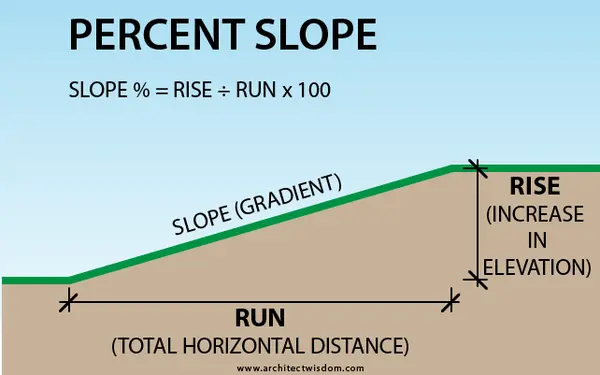Slope percentage is a way of describing how much elevation is gained over a given distance. It can be used to describe the steepness of a hill, the slope of a pipe, or the incline of a sidewalk.
Percent Slope Calculator
1. Calculate Percent Slope (from Rise and Run)
2. Calculate Rise (from Run and Percent Slope)
3. Calculate Run (from Rise and Percent Slope)

How do you calculate slope percentage?
You can calculate the slope percentage by dividing the total elevation gain (rise) by the total horizontal distance (run). You then multiply that number by 100 to give you a percentage. For example, you have a driveway that is 50 feet long and is 4 feet higher at the end than at the beginning.
Example:
Rise / Run X 100 = Slope%
4′ / 50′ X 100 = 8% slope
How is slope represented?
As a ratio
Example: 7:12 (rise:run)
Ratios are most commonly used in architectural applications. It’s the format most commonly used to describe things like roof slope, ramps, or pipe slope.
As a percentage
Example: 2% grade
Percentages are most commonly used for civil and landscape applications to describe the grade of a site.
As an angle
Example: 10°
Angles are measured in degrees and are more commonly used in construction horizontal (in plan) rather than vertically.
Where is slope percentage used?
The slope of a site
The slope of a site can have a significant impact on its use. Gentle slopes are easier to build on and more useful for recreation. Steeper slopes are more expensive to build on and will require more grading or retaining structures to keep the slopes stable. Structures like retaining walls, rip rap, or terracing are examples of retaining structures.
| < 5% slope | Easy to build on and suitable for most outdoor activities. |
| 5%-10% slope | Can be built on without too much difficulty and is suitable for informal outdoor activities. |
| > 10% slope | Challenging to build on or use for outdoor activities. |
| > 25% slope | Subject to erosion and much more difficult to build on. |
>1% is preferred in grassy areas to minimize any standing water
Designing walkways
Walkways should be designed so that they are sloped enough to keep water from puddling, but not so steep to be difficult for some populations to use. 0.5% minimum grading for drainage is suggested, but 1.5% is preferred.
Part of designing a site for everyone is designing an accessible route from handicap parking spaces to building entries (at a minimum). Accessible routes are pathways that meet all ADA requirements. The ADA requirements for slope is that walkaways not be steeper than 1:20 and the cross slope not exceed 1:48.
Designing parking areas
Parking areas are typically impervious (meaning that they collect water) so sloping the parking area is essential to moving water towards catch basins or to pervious areas (like grass) during a rain event. Generally, 1-5% slope is needed for drainage throughout the parking area as a minimum and maximum. 2-3% slopes are preferred at the areas of pavement.
Parking areas need to provide an accessible route at least from the ADA parking to the main entrance of a building.
| 1% slope | 1:100 |
| 2% slope | 1:50 |
| 3% slope | 1:33 |
| 4% slope | 1:25 |
| 5% slope | 1:20 |
ADA Ramps
A ramp is considered anything at a greater slope than 1:20. Ramps cannot exceed 1:12, however. Slopes less than 1:20 are considered a sloped walkway.
Existing buildings can have ramps between 1:12 and 1:10 so long as the maximum rise is less than 6″. Ramps with slopes between 1:10 and 1:8 are permitted in existing buildings so long as the maximum rise is less than 3″.
| Slope | Maximum rise of ramp |
| Ramp slope between 1:10 and 1:8 | 3″ |
| Ramp slope between 1:12 and 1:10 | 6″ |
Roof Slopes
Roof slopes are typically described as a ratio of X to 12 units.
A roof between 1/4:12 and 3:12 is considered a low slope roof.
| Roof Pitch | Slope Percentage | Roof Angle |
| 1/4:12 | 2.08% | 1.19° |
| 1:12 | 8.33% | 4.76° |
| 2:12 | 16.67% | 9.46° |
| 3:12 | 25% | 14.04° |
| 4:12 | 33.33% | 18.43° |
| 5:12 | 41.67% | 22.62° |
| 6:12 | 50% | 26.57° |
| 7:12 | 58.33% | 30.26° |
| 8:12 | 66.67% | 33.69° |
| 9:12 | 75% | 36.87° |
| 10:12 | 83.33% | 39.81° |
| 11:12 | 91.67% | 42.51° |
| 12:12 | 100% | 45° |
| 13:12 | 108.33% | 47.29° |
| 14:12 | 116.67% | 49.40° |
| 15:12 | 125.00% | 51.34° |
| 16:12 | 133.33% | 53.13° |
Slope of piping
Generally, any pipe that needs to drain should be sloped so that liquids and solids don’t pool or build up. The 2018 International Plumbing Code suggests the following for horizontal drainage pipes:
| Size of Pipe | Minimum Slope | Minimum Slope (% slope) |
| 2 1/2″ or less | 1/4″ per foot | 2% |
| 2″ to 6″ | 1/8″ per foot | 1% |
| 8″ or larger | 1/16″ per foot | 0.75% |
